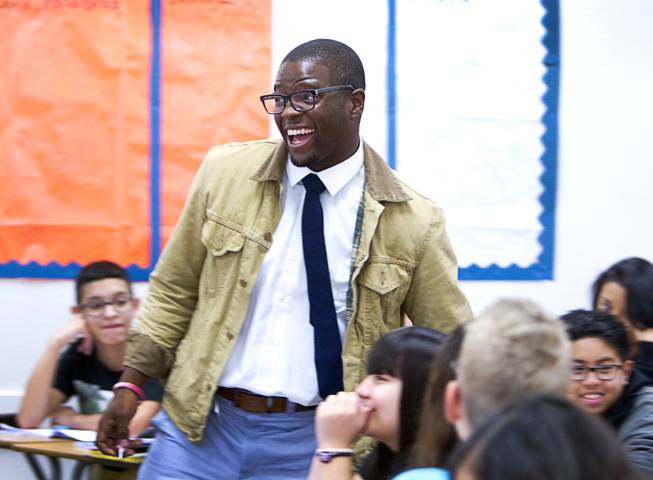
Eric Smith, a second-year Teach for America corps member, smiles during math class Wednesday, Sept. 2, 2015, at O’Callaghan Middle School in Las Vegas.
Thursday, Sept. 3, 2015 | 2 a.m.
“Woooooo!” yells Eric Smith as he skips to the front of his math class at Mike O’Callaghan Middle School. “It’s Friday! You guys excited?!”
“Wooooo!” the students yell back.
“Party at Mr. Smith’s house!” shouts one student.
“Um, no,” the 27-year-old replies. “If y’all show up at my house, I’m not going to be there. In fact, if y’all show up at my house, I’m gonna call the cops.”
All the students laugh.
It’s hard to believe that about a year and a half ago Smith was sitting in an office in Chicago making a lot more money as an accountant. That’s what he went to college for, but he quickly realized it wasn’t what he wanted.
“I used to live that life of going to work, turning on that early morning YouTube, web surfing the first hour and that last hour until I was ready to leave,” he said. “I just dreaded going to work every day.”
He was looking around Chicago for opportunities for volunteer work when he found Teach for America. The organization has been helping the Clark County School District fill empty classrooms in at-risk schools since 2004. This year, Smith is one out of around 225 TFA teachers working in the district. Around 100 of those are teachers in their first year.
The nonprofit, founded in 1989, recruits recent college grads to work two years as a teacher in a low-income school. Corps members go through an intensive summer training course before they’re sent out to schools around the country.
When it came time to fill out his application, he told the organization he preferred somewhere around Chicago, Washington, D.C., or Los Angeles with his family. He ended up getting Las Vegas, his fourth choice.
When he drove into Las Vegas last May, it was the first time he had ever been to the city.
“The big difference is the culture,” he said. “It’s knowing that when you go to the amusement park it means you’re going to Circus Circus, and when you go to the mall it’s going to be next to a casino.”
Before the school year at his classroom at O’Callaghan, Smith decided it needed some kind of theme. Knowing that a large portion of his students were coming from the Hispanic and Latino dominated east valley, he went for a soccer theme. It didn’t go over well.
“Some of the students were like, ‘Mister, I don’t like soccer.’ They weren’t into it,” he said. “I found myself tearing down everything in the room.”
The stress of the classroom leads many new teachers to leave the profession after their first year. A recent study found that 25 percent of TFA teachers planned to quit after their first year, but Smith held on.
“I felt like I jumped in a pool when I didn’t know how to swim,” he said. “I remember every day being so scared and nervous and afraid.”
Smith, who was raised and schooled in a middle-class neighborhood in Silver Spring, Md., realized he had to adapt to the realities of life in a 24-hour city where parents work long hours and students often have to pick up the slack.
His class is fast-paced, fun and designed to hold the attention of even the most distracted students. When it comes time to turn in assignments, students put their papers in one of three folders based on how much they felt they understood the material. That way he knows which students need more help.
“You’d be surprised at the responsibility our students have on a day-to-day basis,” he said. “They help raise their brothers and sisters, they work for their parents after school.”
“There will be days when a student is tired, distracted or hungry because they didn’t have enough time for breakfast,” he said. “That’s very different than what I was exposed to.”
O'Callaghan straddles two worlds. It’s surrounded by middle-class homes in the foothills of Sunrise Mountain, but draws a lot of students from the city’s east side, where a large number of Hispanic and Latino students live. Only 14 percent of the school’s students are white, and 75 percent of the overall student body qualifies for free and reduced lunch.
Smith sees firsthand the obstacles that some of his students face in school, but he doesn’t believe they’re insurmountable.
“We all deal with our own issues,” he said. “But when they come into my class, hopefully I put them in a mood where they can forget about all the things they’re going through and just focus on their classwork, classmates and the teacher.”
He knows math isn’t a particularly interesting subject in school, but he tries to make it interesting. When the bell rings, he stands outside his classroom door joking with students as they walk in single-file. He plays music in class and always carries around a big bag of candy for when a student gives the right answer to a hard math question.
He tries not to dwell on the long list of problems facing the school district like the teacher shortage. But he thinks more people would want to be teachers if they knew the impact they could have on students.
“I feel like I’m living forever. I’m teaching them something that they’re going to teach their kid,” he said. “At the end of the day, while they may not know my name or who I was, something of myself is going to be left.”
“It’s the most rewarding exhaustion I’ve ever felt in my life,” he said.


Join the Discussion:
Check this out for a full explanation of our conversion to the LiveFyre commenting system and instructions on how to sign up for an account.
Full comments policy